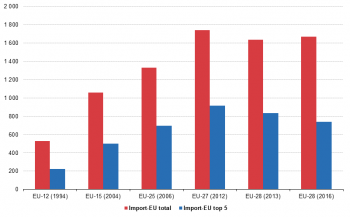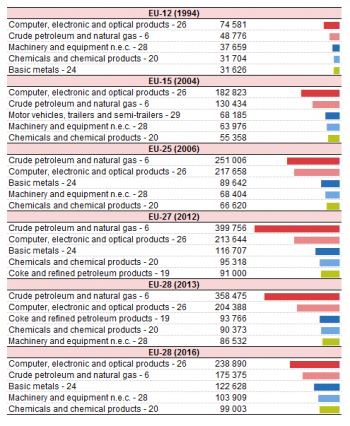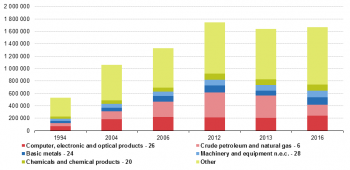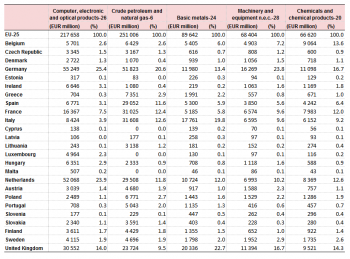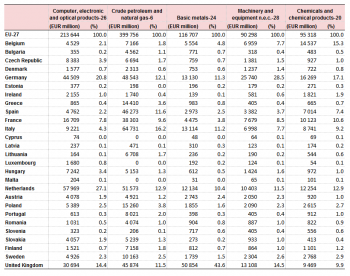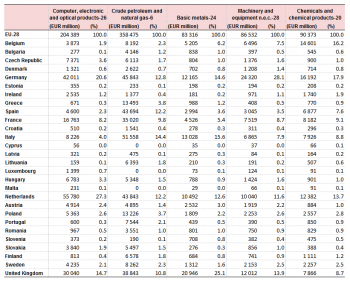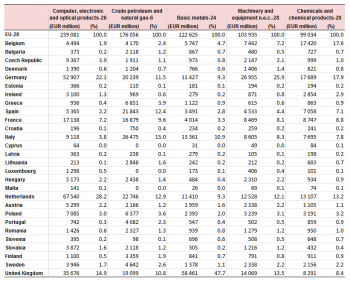Archive:Main goods in extra-EU imports
- Data extracted in Month YYYY. Most recent data: Further Eurostat information, Main tables and Database. Planned article update: (dd) Month YYYY(, hh:00).
This article focuses on the most significant goods by value (according to the CPA classification) in extra-EU imports. It presents statistics for the EU-28 (2013 and 2016), EU-27 (2012), EU-25 (2006), EU-15 (2004) and EU-12 (1994) aggregates. Many of the EU's imports consist of raw materials and intermediary products which are important inputs for EU industries to produce final goods both for the EU's internal market as for extra-EU exports.
Main statistical findings
Evolution of extra-EU imports
Between 1994 and 2004 extra-EU imports more than doubled from EUR 527 billion to EUR 1058 (see Figure 1), equivalent to an average annual growth of 7.2 %. Imports grew even faster between 2004 and 2006 at a rate of 12.1 % annually. Between 2006 and 2012 the growth rate fell to 4.6 %, which brought exports to a peak of EUR 1741 billion. However in the following year imports dropped with 6.1 % to EUR 1635 billion. They grew only slightly between 2013 and 2016 when they were EUR 1667 billion. equivalent to an average annual growth of - 1.2 %. Over the complete period from 1994 to 2016 imports had an average annual growth of 5.4 %. The growth rate for the top 5 imported products were fairly similar for most of the period. However between 1994 and 2004 they were around 5 percentage points higher while between 2013 and 2016 they were 4 percentage points lower. The share of the top 5 products in total imports was lowest in 1994 (43 %) and 2016 (44 %) while peeking in 2012 (53 %).
The 5 most significant products in intra-EU trade
There has been a degree of consistency in those goods that have been most significant in terms of value imported within the EU, although some variations in the evolution of the import figures for these goods can be seen.
In 1994 the top 5 extra-EU imported products by value (see Table 1) were ‘Computer, electronic and optical products’ (EUR 75 billion), ‘Crude petroleum and natural gas‘ (EUR 49 billion), ‘Machinery and equipment’ (EUR 38 billion), ‘Chemicals and chemical products’ and ’Basic metals’ (both EUR 32 billion). In 2004 ’Basic metals’ dropped out of the top 5 in 2004 when its place was taken by 'Motor vehicles' and in 2013 by 'Coke and refined petroleum products' which also appeared in 2012 at the expense of 'Machinery and equipment'. At the end of the period in 2016, the top 5 extra-EU imported goods were the same as in 1994 but 'Basic metal' now occupied the third instead of the fifth.
When we trace back the evolution of the 5 most imported extra-EU products in 2016 (see Figure 2), the top two places were shared by ‘Computer, electronic and optical products’ and ‘Crude petroleum and natural gas‘. The former was ahead in 1994, 2004 and 2016 while the latter led in 2006, 2012 and 2013 partly due to higher oil prices. The remaining products frequently swapped positions but their shares in total extra-EU imports always stayed between 5 % and 8 %.
Between 1994 and 2004 and between 2004 and 2006 imports for all five products increased (see Figure 3). With the exception of ‘Computer, electronic and optical products’ this was also true between 2006 and 2012. However between 2012 and 2013 imports for all 5 products decreased. Finally, with the exception of ‘Crude petroleum and natural gas‘ and 'Computers, electronic and optical products', imports increased again between 2013 an 2016. With 6.4 %, the highest average annual growth over the whole period was achieved by 'Basic metals'. Only ‘Machinery and equipment’ (4.7 %) grew less than 5 % annually.
Extra-EU imports of the most imported goods by Member State
The analysis in this section looks at extra-EU imports by individual EU Member State. Table 2 shows that in 1994, Germany was the largest importer for the 5 most significant products in extra-EU imports. The United Kingdom occupied the second place for 'Computers', 'Machinery' and 'Chemicals'. France, in 'Crude petroleum and natural gas' and Italy in 'Basic metals' occupied the remaining number two spots.
The three countries that joined the EU in 1995, Austria, Finland and Sweden had a combined share in the 5 most imported products ranging from 5.7 % for 'Chemical and chemical products' to 7.3 % for ‘Machinery and equipment’ in 2004. Compared to 1994 the largest increase in imports was for 'Computers' which grew by EUR 108 billion. The Netherlands (+ EUR 34 billion), Germany (+ EUR 26 billion) and the United Kingdom (+ EUR 12 billion) contributed most to this growth while the three new Member States imports amounted to EUR 11billion.
The ten countries that joined the EU in 2004 had a combined shares in the five product group shown, ranging from 5.0 % for largest 'Basic metals' to 7.8 % for Crude petroleum and natural gas in 2006. Between 2004 and 2006 the largest increase in value of imports was for 'Crude petroleum and natural gas' which grew by EUR 121 billion, mainly as a result of rising prices. Germany (+ EUR 23 billion) and the Netherlands (+ EUR 19 billion) contributed most to this growth while the ten new Member States' share in it was EUR 16 billion
Romania and Bulgaria who joined the EU in 2007 had a combined import shares ranging from 0.6 % in ' Computers' to 2.2% in 'Crude petroleum and natural gas' in 2012. Between 2007 and 2012 it was again in 'Crude petroleum and natural gas' that imports increased the most. However in this period it were Italy (+ EUR 33 billion) and the Netherlands (+ EUR 22 billion) that contributed most. Germany (- EUR 3 billion) was the only Member States for which imports of 'Crude petroleum and natural gas' decreased in this period.
Croatia who joined the EU in 2013 had shares below 0.5 % for all five products. In 2013 imports for the five most imported products all fell. In 'Crude petroleum and natural gas' (- EUR 41 billion), Italy (- EUR 13 billion), the Netherlands (- EUR 8 billion) and the United Kingdom (EUR - EUR 7 billion) accounted for two thirds of this decrease. In 'Basic metals' (- EUR 33 billion) the United Kingdom (- EUR 30 billion) accounted for 90 % of the reduction.
Between 2013 and 2016 the composition of the EU remained unchanged. In this period energy prices continued to decline and with that the imports of 'Crude petroleum and natural gas' continued to drop while imports for the other four product groups shown increased. In 'Computers' (+ EUR 35 billion) the largest contributors to the growth were the Netherlands (+ EUR 12 billion) and Germany (+ EUR 11 billion). In 'Basic metals' (+ EUR 39 billion) the United Kingdom (+ EUR 38 billion) had the largest growth while Germany (- EUR 0.7 billion), Austria (- EUR 0.6 billion) and France - EUR (0.7 billion) had the largest decreases in this period.
Data sources and availability
EU data comes from Eurostat’s COMEXT database.
COMEXT is the Eurostat reference database for international trade in goods. It provides access not only to both recent and historical data from the EU Member States but also to statistics of a significant number of non-EU countries. International trade aggregated and detailed statistics disseminated from Eurostat website are compiled from COMEXT data according to a monthly process. Because COMEXT is updated on a daily basis, data published on the website may differ from data stored in COMEXT in case of recent revisions.
European statistics on international trade in goods are compiled according to the EU concepts and definitions and may, therefore, differ from national data published by Member States.
Product classification
Classification of products by activity (CPA) is a statistical classification of products and services obligatory for all EU Member States. CPA classifies products by activity in which they are produced. Products are transportable goods and services. The CPA is a product classification whose elements are related to activities as defined by NACE Rev. 2. Each product - whether it be a transportable or a non-transportable good or a service - is assigned to one single NACE Rev. 2 activity. The linkage to activities as defined by NACE Rev. 2 gives the CPA a structure parallel to that of NACE Rev. 2 at all levels distinguished by NACE Rev. 2.
Unit of measure
Trade values are expressed in millions (106) of euros. They correspond to the statistical value, i.e. to the amount which would be invoiced in case of sale or purchase at the national border of the reporting country. It is called a FOB value (free on board) for exports and a CIF value (cost, insurance, freight) for imports.
Context
Europe is the world's largest exporter of manufactured goods and services, and is itself the biggest export market for around 80 countries. Trade is an important indicator of Europe's prosperity and place in the world, and the bloc has become deeply integrated into global markets both for the products it sources and the exports it sells.
Because the 28 Member States of the European Union share a single market and a single external border, they also have a single trade policy. Both in the World Trade Organization, where the rules of international trade are agreed and enforced, and with individual trading partners, EU Member States speak and negotiate collectively.
See also
Further Eurostat information
Data visualisation
- Did you know? Some funny and curious facts about trade of the EU
- Top 5 partners in trade in goods
- My Country in a bubble
Main tables
- International trade in goods - long-term indicators (t_ext_go_lti)
- International trade of machinery and transport equipment (SITC 7), by declaring country (tet00009)
- Extra-EU28 trade of machinery and transport equipment (SITC 7), by Member State (tet00059)
- Extra-EU28 trade of machinery and transport equipment (SITC 7), by main partners (tet00030)
- International trade in goods - short-term indicators (t_ext_go_sti)
- Imports of goods - machinery and transport equipment (teiet170)
- Exports of goods - machinery and transport equipment (teiet070)
Database
- International trade in goods - aggregated data (ext_go_agg)
- International trade in goods - detailed data (detail)
Dedicated section
Methodology / Metadata
- International trade in goods statistics - background
- International trade in goods (ESMS metadata file — ext_go_esms)
- User guide on European statistics on international trade in goods
Source data for tables, figures and maps (MS Excel)
Other information — Legal background
- Regulation (EC) No 471/2009 of 6 May 2009 on Community statistics relating to external trade with non-member countries
- Regulation (EU) No 92/2010 of 2 February 2010 implementing Regulation (EC) No 471/2009, as regards data exchange between customs authorities and national statistical authorities, compilation of statistics and quality assessment
- Regulation (EU) No 113/2010 of 9 February 2010 implementing Regulation (EC) No 471/2009 , as regards trade coverage, definition of the data, compilation of statistics on trade by business characteristics and by invoicing currency, and specific goods or movements.
External links
Notes
[[Category:<Subtheme category name(s)>|Name of the statistical article]] [[Category:<Statistical article>|Name of the statistical article]]
Delete [[Category:Model|]] below (and this line as well) before saving!
